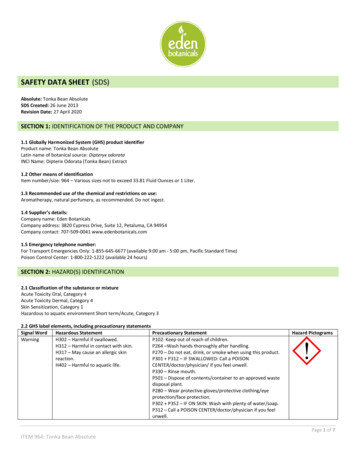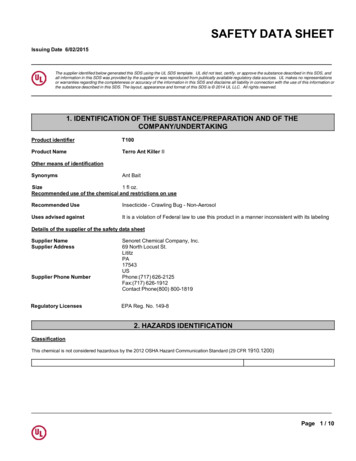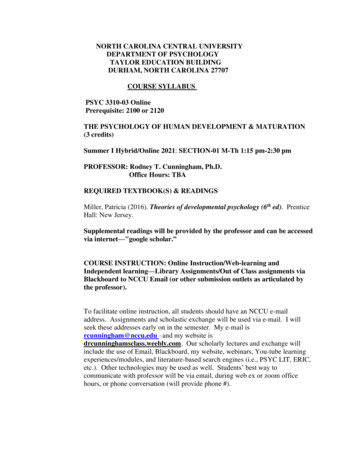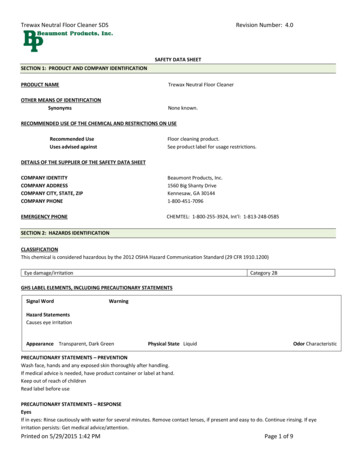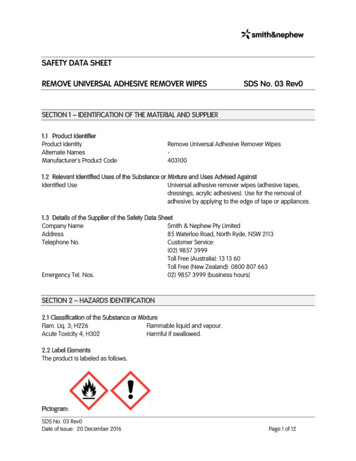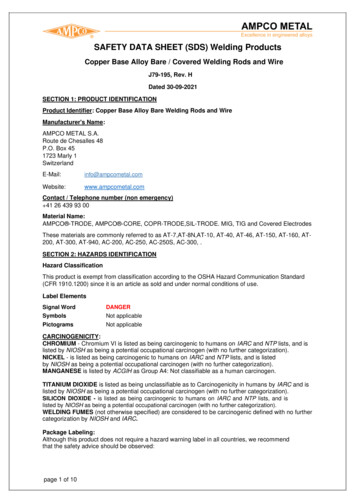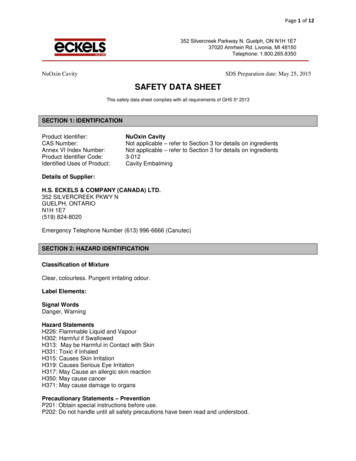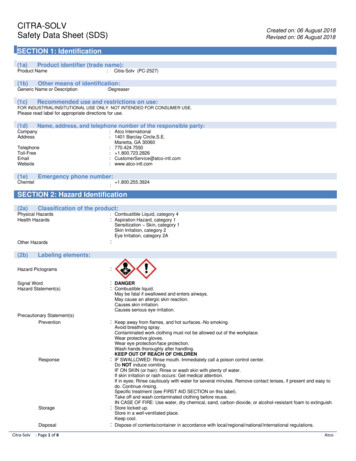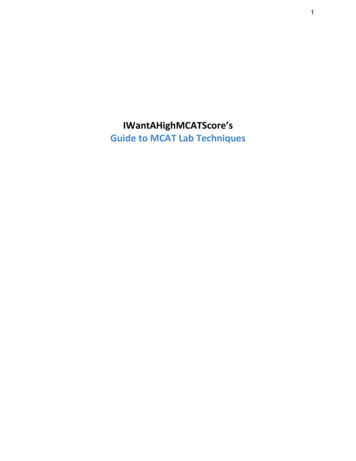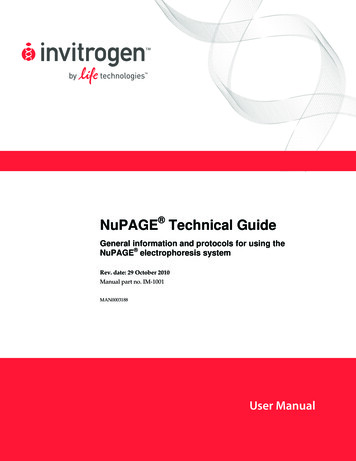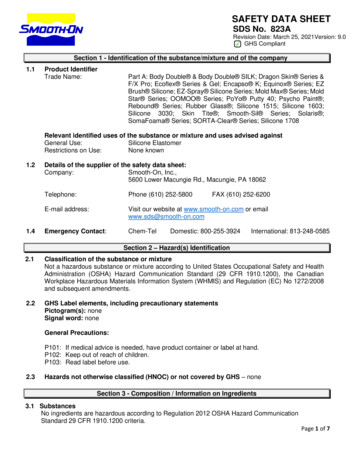
Transcription
SAFETY DATA SHEETSDS No. 823ARevision Date: March 25, 2021Version: 9.0GHS CompliantSection 1 - Identification of the substance/mixture and of the company1.1Product IdentifierTrade Name:Part A: Body Double & Body Double SILK; Dragon Skin Series &F/X Pro; Ecoflex Series & Gel; Encapso K; Equinox Series; EZBrush Silicone; EZ-Spray Silicone Series; Mold Max Series; MoldStar Series; OOMOO Series; PoYo Putty 40; Psycho Paint ;Rebound Series; Rubber Glass ; Silicone 1515; Silicone 1603;Silicone 3030; Skin Tite ; Smooth-Sil Series; Solaris ;SomaFoama Series; SORTA-Clear Series; Silicone 1708Relevant identified uses of the substance or mixture and uses advised againstGeneral Use:Silicone ElastomerRestrictions on Use:None known1.21.4Details of the supplier of the safety data sheet:Company:Smooth-On, Inc.,5600 Lower Macungie Rd., Macungie, PA 18062Telephone:Phone (610) 252-5800FAX (610) 252-6200E-mail address:Visit our website at www.smooth-on.com or emailwww.sds@smooth-on.comEmergency Contact:Chem-TelDomestic: 800-255-3924International: 813-248-0585Section 2 – Hazard(s) Identification2.1Classification of the substance or mixtureNot a hazardous substance or mixture according to United States Occupational Safety and HealthAdministration (OSHA) Hazard Communication Standard (29 CFR 1910.1200), the CanadianWorkplace Hazardous Materials Information System (WHMIS) and Regulation (EC) No 1272/2008and subsequent amendments.2.2GHS Label elements, including precautionary statementsPictogram(s): noneSignal word: noneGeneral Precautions:P101: If medical advice is needed, have product container or label at hand.P102: Keep out of reach of children.P103: Read label before use.2.3Hazards not otherwise classified (HNOC) or not covered by GHS – noneSection 3 - Composition / Information on Ingredients3.1 SubstancesNo ingredients are hazardous according to Regulation 2012 OSHA Hazard CommunicationStandard 29 CFR 1910.1200 criteria.Page 1 of 7
SDS No. 823ASection 4 - First Aid Measures4.1Description of first aid measuresInhalationRemove source(s) of contamination and move victim to fresh air. If breathing has stopped, giveartificial respiration, then oxygen if needed. Contact physician immediately.Eye ContactFlush eyes with plenty of water. If irritation persists, seek medical attention.Skin ContactIn case of skin contact, wash thoroughly with soap and water.IngestionDo not induce vomiting unless instructed by a physician. Never give anything by mouth to anunconscious person.4.2Most important symptoms and effects, both acute and delayedNone known.4.3After first aid, get appropriate in-plant, paramedic, or community medical support.Section 5 - Fire-Fighting Measures5.1Extinguishing MediaWater Fog, Dry Chemical, and Carbon Dioxide Foam5.2Special hazards arising from the substance or mixtureNone known.5.3Advice for firefightersUse water spray to cool fire-exposed surfaces and to protect personnel. Shut off “fuel” to fire. If aleak or spill has not ignited, use water spray to disperse the vapors. Either allow fire to burn undercontrolled conditions or extinguish with foam or dry chemical. Try to cover liquid spills with foam.Because fire may produce toxic thermal decomposition products, wear a self-contained breathingapparatus (SCBA) with a full-face piece operated in pressure demand or positive-pressure mode.Section 6 - Accidental Release Measures6.1Personal precautions, protective equipment and emergency proceduresOnly properly protected personnel should remain in the spill area; dike and contain spill. Stop orreduce discharge if it can be done safely.6.2Environmental precautionsStop spill/release if it can be done safely. Prevent spilled material from entering sewers, storm drainsor unauthorized drainage systems and natural waterways by using sand, earth, or other appropriatebarriers. No special environmental precautions required.6.3Methods and material for containment and cleaning upPut on appropriate protective gear including NIOSH/MSHA approved self-containedbreathing apparatus, rubber boots and heavy rubber gloves. Dike and contain spill; Absorbor scrape up excess into suitable container for disposal; wash area with dilute ammonia solution.Page 2 of 7
SDS No. 823A6.4Reference to other sectionsSee Section 3 for list of Hazardous Ingredients; Sections 8 for Exposure Controls; and Section 13for Disposal.Section 7 - Handling and Storage7.1Precautions for safe handlingUse good general housekeeping procedures. Wash hands after use. Do not get in eyes, on skin oron clothing. Do not breathe vapors or mists. Use good personal hygiene practices.7.2Conditions for safe storage, including any incompatibilitiesKeep container(s) tightly closed and properly labeled. Store in cool, dry, well ventilated place awayfrom heat, direct sunlight, strong oxidizers and any incompatibles. Store in approved containers andprotect against physical damage. Keep containers securely sealed when not in use. Indoor storageshould meet local standards and appropriate fire codes. Containers that have been opened must becarefully resealed to prevent leakage. Empty containers retain residue and may be dangerous. Avoidwater contamination.7.3Specific end use(s)These precautions are for room temperature handling. Other uses including elevated temperaturesor aerosol/spray applications may require added precautions.Section 8 - Exposure Controls / Personal Protection8.1Control parametersNone defined8.2Exposure controlsRespiratory ProtectionRespiratory protection is not normally required when using this product in open environments withadequate ventilation.Hand ProtectionWear any liquid-tight gloves such as butyl rubber, neoprene or PVC.Eye ProtectionSafety glasses with side shields per OSHA eye- and face-protection regulations 29 CFR 1910.133and European Standard EN166. Contact lenses are not eye protective devices. Appropriate eyeprotection must be worn instead of, or in conjunction with contact lenses.Other Protective Clothing/EquipmentAdditional protective clothing or equipment is not normally required. Provide eye bath and safetyshower.CommentsNever eat, drink, or smoke in work areas. Practice good personal hygiene after usingthis material, especially before eating, drinking, smoking, using the toilet, or applying cosmetics.Wash thoroughly after handling.Page 3 of 7
SDS No. 823ASection 9 - Physical and Chemical Properties9.1Information on basic physical and chemical properties:Appearance:Odor:pH:Flash Point:viscous liquidMild to sweet odorNo data 300 FMelting / freezing point:Low / high boiling point:Upper flammabilitylimits:Lower flammabilitylimits:No dataNo dataNo dataNo dataVapor pressure:Vapor density (Air 1):Evaporation rate:Solubility in water:Specific Gravity(H2O 1, at 4 C):Relative density:Decompositiontemperature:Viscosity:None (Polymeric Resin) 1No dataInsoluble1.05 – 1.15No dataNo data5,000 – 50,000 centipoiseSection 10 - Stability and Reactivity10.1 ReactivityNo hazardous reactions if stored and handled as prescribed/indicated., No corrosive effect onmetal. Not fire propagating.10.2 Chemical stabilityThese products are stable at room temperature in closed containers under normal storage andhandling conditions.10.3 Possibility of hazardous reactionsHazardous polymerization cannot occur10.4 Conditions to avoidNone known10.5 Incompatible materialsStrong bases and acids10.6 Hazardous decomposition productsThermal oxidative decomposition can produce carbon oxides, gasses/vapors, and traces ofincompletely burned carbon compounds.Section 11- Toxicological Information11.1 Information on toxicological effectsAcute ToxicityNo data availableSkin Corrosion/IrritationNo data availableSerious Eye Damage/IrritationNo data availableRespiratory/Skin SensitizationNo data availablePage 4 of 7
SDS No. 823AGerm Cell MutagenicityNo data availableCarcinogenicityNo component of these products present at levels greater than or equal to 0.1% is identified as acarcinogen or potential carcinogen by IARC, ACGIH or NTP.Reproductive ToxicityNo data availableSpecific Target Organ Toxicity – Single ExposureNo data availableSpecific Target Organ Toxicity – Repeated ExposureNo data availableAspiration HazardNo data availablePotential Health Effects – MiscellaneousNo data availableSection 12 - Ecological Information12.1 ToxicityNo data available12.2 Persistence and DegradabilityNo data available12.3 Bioaccumulative PotentialNo data available12.4 Mobility in SoilNo data available12.5 Results of PBT and vPvB assessmentNo data available12.6 Other Adverse EffectsNo data availableSection 13 - Disposal Considerations13.1 Waste treatment methodsUnder Resource Conservation and Recovery Act (RCRA) it is the responsibility of the user of theproduct to determine at the time of disposal whether the product meets RCRA criteria for hazardouswaste as defined in 40 CFR Part 261. Waste management should be in full compliance with federal,state and local laws. Regulations may vary in various locations. Waste characterizations andcompliance with applicable laws are the responsibility solely of the waste generator.Container disposalSteel drums must be emptied and can be sent to a licensed drum reconditioner for reuse, a scrapmetal dealer or an approved landfill. Do not attempt to refill or clean containers since residue isdifficult to remove. Under no circumstances should empty drums be burned or cut open with gas orPage 5 of 7
SDS No. 823Aelectric torch as toxic decomposition products may be liberated. Do not reuse empty containers.Section 14 - Transport InformationNot regulated by DOT / IMDG / IATASection 15 - Regulatory Information15.1Safety health and environmental regulations/legislation specific for thesubstance or mixture:REACH: Regulation (EC) No 1907/2006 of The European Parliament and of The Council ofDecember 2006 (including amendments and corrigenda as of 16 July 2019)This product complies with REACH or is not subject to regulation under REACH. The product doesnot contain an ingredient listed on either the Candidate List or Authorization List for Substances ofVery High Concern (SVHC).In the United States (EPA Regulations)TSCA Inventory Status (40 CFR710)All components of this formulation are listed in the TSCA Inventory. No component of this formulationhas been determined to be subject to manufacturing or use restrictions under the Significant NewUse Rules (SNURs).CERCLA Hazardous Substance List (40 CFR 302.4)None known.SARA 302 ComponentsNo chemicals in this material are subject to the reporting requirements of SARA Title III, Section302.Superfund Amendments and Reauthorization Act of 1986 Title lll (Emergency Planning andcommunity Right-to-Know Act of 1986) Sections 311 and 312NoneSuperfund Amendments and Reauthorization Act of 1986 Title lll (Emergency Planning andCommunity Right-to-Know Act of 1986) Section 313This material does not contain any chemical components with known CAS numbers that exceedthe threshold (De Minimis) reporting levels established by SARA Title III, Section 313.California Proposition 65This product does not intentionally contain any chemicals known to the state of California to causecancer, birth defects or other reproductive harm.15.2 Chemical safety assessmentNo chemical safety assessment has been carried out for this substance/mixture by the supplier.Page 6 of 7
SDS No. 823A16 - Other InformationHMISH 1F 0R 001000NFPARevision Date: March 25, 2021 Revision: 9Abbreviations and acronymsACGIH-American Conference of Governmental Industrial Hygienists; ANSI-American National StandardsInstitute; Canadian TDG-Canadian Transportation of Dangerous Goods; CAS-Chemical Abstract Service;Chemtrec-Chemical Transportation Emergency Center (US); CHIP-Chemical Hazard Information andPackaging; DSL-Domestic Substances List; EC-Equivalent Concentration; EH40 (UK)-HSE GuidanceNote EH40 Occupational Exposure Limits; EPCRA-Emergency Planning and Community Right-To-KnowAct; ESL-Effects screening levels; GHS-Globally Harmonized System of Classification and Labelling ofChemicals; HMIS-Hazardous Material Information Service; IATA-International Air Transport Association;IMDG-International Maritime Dangerous Goods Code; LC-LethalConcentration; LD-Lethal Dose; LELLower Explosion Level; NFPA-National Fire Protection Association; OEL-Occupational Exposure Limit;OSHA-Occupational Safety and Health Administration, US Dept. of Labor; PEL-Permissible ExposureLimit; SARA (Title III)-Superfund Amendments and Reauthorization Act; SARA 313-SuperfundAmendments and Reauthorization Act, Section 313; SCBA-Self-Contained Breathing Apparatus; STELShort Term Exposure Limit; TCEQ-Texas Commission on Environmental Quality; TLV-Threshold LimitValue; TSCA-Toxic Substances Control Act Public Law 94-469; TWA-Time Weighted Value; UEL-UpperExplosion Level; US DOT-US Department of Transportation; WHMIS-Workplace Hazardous MaterialsInformation System.DisclaimerThe information contained in this Safety Data Sheet (SDS) is considered accurate as of the versiondate. However, no warranty is expressed or implied regarding the accuracy of the data. Since the use ofthis product is not within the control of Smooth-On Inc., it is the user's obligation to determine the suitabilityof the product for its intended application and assumes all risk and liability for its safe use.This SDS is prepared to comply with the Globally Harmonized System of Classification and Labelling ofChemicals (GHS) as prescribed by the United States (US) Occupational Safety and Health Administration(OSHA) Hazard Communication Standard (29 CFR 1910.1200), the Canadian Workplace HazardousMaterials Information System (WHMIS), and European Union Regulation (EC) No 1907/2006 of theEuropean Parliament and of the Council of 18 December 2006 (REACH).Classifications of the chemical in accordance with 29 CFR 1910.1200, signal word, hazard andprecautionary statement(s), symbol(s) and other information are based on listed concentration of eachhazardous ingredient. Unlisted ingredients are not "hazardous" per the OSHA Hazard CommunicationStandard (29 CFR 1910.1200), WHMIS and EC No 1907/2006 and are considered trade secrets underUS Federal Law (29 CFR and 40 CFR), Canadian Law (Health Canada Legislation), and European UnionDirectives.Page 7 of 7
SAFETY DATA SHEETSDS No. 823BRevision Date: March 31, 2021 Version: 10.0GHS CompliantSection 1 - Identification of the substance/mixture and of the company/undertaking1.1Product IdentifierTrade Name:Part B: Body Double & Body Double SILK; Dragon Skin Series &F/X Pro; Ecoflex Series & Gel; Encapso K; Equinox Series; EZBrush Silicone; EZ-Spray Silicone Series; Psycho Paint ; MoldStar Series; OOMOO Series; Rebound Series; Rubber Glass ;Skin Tite ; Smooth-Sil Series; Soma Foama 15 and 25; Solaris ;SORTAClear Series; Silicone 1603; Silicone 17081.2Relevant identified uses of the substance or mixture and uses advised againstGeneral Use:Silicone Elastomer CrosslinkerRestrictions on Use:None known1.3Details of the supplier of the safety data sheet:Company:Smooth-On, Inc.,5600 Lower Macungie Rd., Macungie, PA 180621.4Telephone:Phone (610) 252-5800FAX (610) 252-6200E-mail address:Visit our website at www.smooth-on.com or emailwww.sds@smooth-on.comEmergency Contact:Chem-TelDomestic: 800-255-3924International: 813-248-0585Section 2 – Hazard(s) Identification2.1Classification of the substance or mixtureNot a hazardous substance or mixture according to United States Occupational Safety and HealthAdministration (OSHA) Hazard Communication Standard (29 CFR 1910.1200), the CanadianWorkplace Hazardous Materials Information System (WHMIS) and Regulation (EC) No 1272/2008and subsequent amendments.2.2GHS Label elements, including precautionary statementsPictogram(s): noneSignal word: noneGeneral Precautions:P101: If medical advice is needed, have product container or label at hand.P102: Keep out of reach of children.P103: Read label before use.2.3Hazards not otherwise classified (HNOC) or not covered by GHS – noneSection 3 - Composition / Information on Ingredients3.1 SubstancesNo ingredients are hazardous according to Regulation 2012 OSHA Hazard CommunicationStandard 29 CFR 1910.1200 criteria.Page 1 of 7
SDS No. 823BSection 4 - First Aid Measures4.1Description of first aid measuresInhalationRemove source(s) of contamination and move victim to fresh air. If breathing has stopped, giveartificial respiration, then oxygen if needed. Contact physician immediately.Eye ContactFlush eyes with plenty of water. If irritation persists, seek medical attention.Skin ContactIn case of skin contact, wash thoroughly with soap and water.IngestionDo not induce vomiting unless instructed by a physician. Never give anything by mouth to anunconscious person.4.2Most important symptoms and effects, both acute and delayedNone known.4.3After first aid, get appropriate in-plant, paramedic, or community medical support.None known.Section 5 - Fire-Fighting Measures5.1Extinguishing MediaWater Fog, Dry Chemical, and Carbon Dioxide Foam5.2Special hazards arising from the substance or mixtureNone known.5.3Advice for firefightersUse water spray to cool fire-exposed surfaces and to protect personnel. Shut off “fuel” to fire. If a leakor spill has not ignited, use water spray to disperse the vapors. Either allow fire to burn under controlledconditions or extinguish with foam or dry chemical. Try to cover liquid spills with foam. Because firemay produce toxic thermal decomposition products, wear a self-contained breathing apparatus(SCBA) with a full-face piece operated in pressure demand or positive-pressure mode.Section 6 - Accidental Release Measures6.1Personal precautions, protective equipment and emergency proceduresOnly properly protected personnel should remain in the spill area; dike and contain spill. Stop orreduce discharge if it can be done safely.6.2Environmental precautionsNo special environmental precautions required.6.3Methods and material for containment and cleaning upPut on appropriate protective gear including NIOSH/MSHA approved self-contained breathingapparatus, rubber boots and heavy rubber gloves. Dike and contain spill; absorb or scrape up excessinto suitable container for disposal; wash area with dilute ammonia solution. Stop or reducedischarge if it can be done safely. Follow applicable OSHA regulations (29 CFR 1910.120) fordisposal.Page 2 of 7
SDS No. 823B6.4Reference to other sectionsSee Section 3 for list of Hazardous Ingredients; Sections 8 for Exposure Controls; and Section 13for Disposal.Section 7 - Handling and Storage7.1Precautions for safe handlingUse good general housekeeping procedures. Wash hands after use. Do not get in eyes, on skin oron clothing. Do not breathe vapors or mists. Use good personal hygiene practices.7.2Conditions for safe storage, including any incompatibilitiesKeep container(s) tightly closed and properly labeled. Store in cool, dry, well ventilated place awayfrom heat, direct sunlight, strong oxidizers and any incompatibles. Store in approved containers andprotect against physical damage. Keep containers securely sealed when not in use. Indoor storageshould meet local standards and appropriate fire codes. Containers that have been opened must becarefully resealed to prevent leakage. Empty containers retain residue and may be dangerous. Avoidwater contamination.7.3Specific end use(s)These precautions are for room temperature handling. Other uses including elevated temperaturesor aerosol/spray applications may require added precautions.Section 8 - Exposure Controls / Personal Protection8.1Control parametersNone defined8.2Exposure controlsRespiratory ProtectionRespiratory protection is not normally required when using this product in open environments withadequate ventilation.Hand ProtectionWear any liquid-tight gloves such as butyl rubber, neoprene or PVC.Eye ProtectionSafety glasses with side shields per OSHA eye- and face-protection regulations 29 CFR 1910.133and European Standard EN166. Contact lenses are not eye protective devices. Appropriate eyeprotection must be worn instead of, or in conjunction with contact lenses.Other Protective Clothing/EquipmentAdditional protective clothing or equipment is not normally required. Provide eye bath and safetyshower.CommentsNever eat, drink, or smoke in work areas. Practice good personal hygiene after usingthis material, especially before eating, drinking, smoking, using the toilet, or applying cosmetics.Wash thoroughly after handling.Page 3 of 7
SDS No. 823BSection 9 - Physical and Chemical Properties9.1Information on basic physical and chemical properties:Appearance:Odor:pH:Flash Point:viscous liquidMild to sweet odor(non-aqueous) 300 FMelting / freezing point:Low / high boiling point:Upper flammability limits:No dataNo dataLower flammability limits:No dataNo dataVapor pressure:Vapor density (Air 1):Evaporation rate:Solubility in water:Specific Gravity(H2O 1, at 4 C):Relative density:Decompositiontemperature:Viscosity:No data 1.0No dataInsoluble1.07No dataNo data5,000 – 50,000 centipoiseSection 10 - Stability and Reactivity10.1 ReactivityNo hazardous reactions if stored and handled as prescribed/indicated., No corrosive effect onmetal. Not fire propagating.10.2 Chemical stabilityThese products are stable at room temperature in closed containers under normal storage andhandling conditions.10.3 Possibility of hazardous reactionsHazardous polymerization cannot occur10.4 Conditions to avoidNone known10.5 Incompatible materialsStrong bases and acids10.6 Hazardous decomposition productsThermal oxidative decomposition can produce carbon oxides, gasses/vapors, and traces ofincompletely burned carbon compounds.Section 11- Toxicological Information11.1 Information on toxicological effectsAcute ToxicityNo data availableSkin Corrosion/IrritationNo data availableSerious Eye Damage/IrritationNo data availableRespiratory/Skin SensitizationNo data availableGerm Cell MutagenicityPage 4 of 7
SDS No. 823BNo data availableCarcinogenicityNo component of these products present at levels greater than or equal to 0.1% is identified as acarcinogen or potential carcinogen by IARC, ACGIH or NTP.Reproductive ToxicityNo data availableSpecific Target Organ Toxicity – Single ExposureNo data availableSpecific Target Organ Toxicity – Repeated ExposureNo data availableAspiration HazardNo data availablePotential Health Effects – MiscellaneousNo data availableSection 12 - Ecological Information12.1 ToxicityNo data available12.2 Persistence and DegradabilityNo data available12.3 Bioaccumulative PotentialNo data available12.4 Mobility in SoilNo data available12.5 Results of PBT and vPvB assessmentNo data available12.6 Other Adverse EffectsNo data availableSection 13 - Disposal Considerations13.1 Waste treatment methodsUnder Resource Conservation and Recovery Act (RCRA) it is the responsibility of the user of theproduct to determine at the time of disposal whether the product meets RCRA criteria for hazardouswaste as defined in 40 CFR Part 261. Waste management should be in full compliance with federal,state and local laws. Regulations may vary in various locations. Waste characterizations andcompliance with applicable laws are the responsibility solely of the waste generator.Container disposalSteel drums must be emptied and can be sent to a licensed drum reconditioner for reuse, a scrapmetal dealer or an approved landfill. Do not attempt to refill or clean containers since residue isdifficult to remove. Under no circumstances should empty drums be burned or cut open with gas orelectric torch as toxic decomposition products may be liberated. Do not reuse empty containers.Page 5 of 7
SDS No. 823BSection 14 - Transport InformationNot regulated by DOT / IMDG / IATASection 15 - Regulatory Information15.1Safety health and environmental regulations/legislation specific for thesubstance or mixture:REACH: Regulation (EC) No 1907/2006 of The European Parliament and of The Council ofDecember 2006 (including amendments and corrigenda as of 16 July 2019)This product complies with REACH or is not subject to regulation under REACH. The product doesnot contain an ingredient listed on either the Candidate List or Authorization List for Substances ofVery High Concern (SVHC).In the United States (EPA Regulations)TSCA Inventory Status (40 CFR710)All components of this formulation are listed in the TSCA Inventory. No component of thisformulation has been determined to be subject to manufacturing or use restrictions under theSignificant New Use Rules (SNURs).CERCLA Hazardous Substance List (40 CFR 302.4)None known.SARA 302 ComponentsNo chemicals in this material are subject to the reporting requirements of SARA Title III, Section302.Superfund Amendments and Reauthorization Act of 1986 Title lll (Emergency Planning andcommunity Right-to-Know Act of 1986) Sections 311 and 312NoneSuperfund Amendments and Reauthorization Act of 1986 Title lll (Emergency Planning andCommunity Right-to-Know Act of 1986) Section 313This material does not contain any chemical components with known CAS numbers that exceedthe threshold (De Minimis) reporting levels established by SARA Title III, Section 313.California Proposition 65This product does not intentionally contain any chemicals known to the state of California to causecancer, birth defects or other reproductive harm.15.2 Chemical safety assessmentNo chemical safety assessment has been carried out for this substance/mixture by the supplier.Page 6 of 7
SDS No. 823B16 - Other Information0HMISH 1F 0R 01000NFPARevision Date: March 31, 2021Version: 10.0Abbreviations and acronymsACGIH-American Conference of Governmental Industrial Hygienists; ANSI-American National StandardsInstitute; Canadian TDG-Canadian Transportation of Dangerous Goods; CAS-Chemical Abstract Service;Chemtrec-Chemical Transportation Emergency Center (US); CHIP-Chemical Hazard Information andPackaging; DSL-Domestic Substances List; EC-Equivalent Concentration; EH40 (UK)-HSE GuidanceNote EH40 Occupational Exposure Limits; EPCRA-Emergency Planning and Community Right-To-KnowAct; ESL-Effects screening levels; GHS-Globally Harmonized System of Classification and Labelling ofChemicals; HMIS-Hazardous Material Information Service; IATA-International Air Transport Association;IMDG-International Maritime Dangerous Goods Code; LC-Lethal Concentration; LD-Lethal Dose; LELLower Explosion Level; NFPA-National Fire Protection Association; OEL-Occupational Exposure Limit;OSHA-Occupational Safety and Health Administration, US Dept. of Labor; PEL-Permissible ExposureLimit; SARA (Title III)-Superfund Amendments and Reauthorization Act; SARA 313-SuperfundAmendments and Reauthorization Act, Section 313; SCBA-Self-Contained Breathing Apparatus; STELShort Term Exposure Limit; TCEQ-Texas Commission on Environmental Quality; TLV-Threshold LimitValue; TSCA-Toxic Substances Control Act Public Law 94-469; TWA-Time Weighted Value; UEL-UpperExplosion Level; US DOT-US Department of Transportation; WHMIS-Workplace Hazardous MaterialsInformation System.DisclaimerThe information contained in this Safety Data Sheet (SDS) is considered accurate as of the versiondate. However, no warranty is expressed or implied regarding the accuracy of the data. Since the use ofthis product is not within the control of Smooth-On Inc., it is the user's obligation to determine the suitabilityof the product for its intended application and assumes all risk and liability for its safe use.This SDS is prepared to comply with the Globally Harmonized System of Classification and Labelling ofChemicals (GHS) as prescribed by the United States (US) Occupational Safety and Health Administration(OSHA) Hazard Communication Standard (29 CFR 1910.1200), the Canadian Workplace HazardousMaterials Information System (WHMIS), and European Union Regulation (EC) No 1907/2006 of theEuropean Parliament and of the Council of 18 December 2006 (REACH).Classifications of the chemical in accordance with 29 CFR 1910.1200, signal word, hazard andprecautionary statement(s), symbol(s) and other information are based on listed concentration of eachhazardous ingredient. Unlisted ingredients are not "hazardous" per the OSHA Hazard CommunicationStandard (29 CFR 1910.1200), WHMIS and EC No 1907/2006 and are considered trade secrets underUS Federal Law (29 CFR and 40 CFR), Canadian Law (Health Canada Legislation), and European UnionDirectives.Page 7 of 7
SAFETY DATA SHEET SDS No. 823A Revision Date: March 25, 2021Version: 9.0 GHS Compliant Page 1 of 7 Section 1 - Identification of the substance/mixture and of the company
